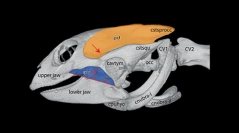

 Comptes Rendus Palevol
14 (6-7) - Pages 527-548
Comptes Rendus Palevol
14 (6-7) - Pages 527-548Extant turtles are characterized by diverse marginal reductions in their temporal skull region. Among other minor factors, their modes of neck retraction were hypothesized to have a key influence for shaping that region through evolution. A recent study on the mobility of the turtle neck highlighted the possibility that stem turtles, such as Proganochelys quenstedti were able to easily retract their necks by laterally tucking the skull under the anterior edge of the shell. A small emargination in the “cheek” of this species could be correlated to its mode of neck retraction. In the present study, by using a geometric morphometric approach, I correlated the curve shapes of retracted necks and other neck positions with the expansion of marginal reductions in turtle skulls. I hypothesize based on morphospace distributions that neck retraction evolved only once within turtle evolution and that pleurodiran and cryptodiran turtle retraction are directly and independently derived from ancestral neck tucking. Pleurodires evolved a middle kink in their elongated neck for lateral retraction. At the dawn of turtle evolution, associated to the ancestrally retracted (laterally rotated) neck, the cervicals were less specialized than in extant taxa. For cryptodires, that condition may have permitted a transitional, intervertebral rotation towards the vertical neck orientation found in that group during retraction. It retained the ancestral characteristically oriented curvature of the cervical column. I found that the cryptodiran mode of retraction and the ventral neck flexion in all turtles are strongly correlated to the expansion of the occiput emargination. Pleurodiran retraction, however, does not influence skull shape to such a degree. The “cheek” emargination is correlated with the expansion of the “occiput” emargination and appears to occur in correlation to the fixation of the palatoquadrate to the braincase in crown turtles. Neck related forces acting on the skull and ventral neck flexion are also hypothesized to be crucial factors for the reduction of a potential temporal fenestration inherited from a potentially fenestrated turtle ancestor.
Testudines, Proganochelys quenstedti, Neck retraction, Emargination, Fenestration, Principal component analysis